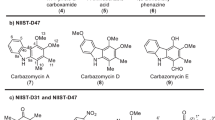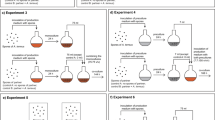Abstract
The strain Sphingomonas sp. VKM V-2434 converts the mixture of seven polyaromatic compounds (PACs): fluorene, dibenzothiophene, carbazole, phenanthrene, anthracene, fluoranthene, and pyrene. The effect of each of the above PACs on the rate of mixture conversion was determined. The following two strains, which utilize the substances inhibiting the studied process, were added to the culture: strain FON-11 utilizing 9-fluorenone (fluorene metabolite) and strain CBZ-21 utilizing carbazole. In the case of the mixed culture of three strains, conversion rates were 1.5 and 1.2–3.8 times higher for the PAC mixture and its individual components, respectively, than the rates for Sphingomonas sp. VKM V-2434 monoculture. The degree of degradation of PAC conversion products increased from 32 to 44%. The rate of PAC conversion by the mixed culture exceeded the sum of conversion rates for the individual component strains; this cooperative effect was particularly marked for anthracene and pyrene.
Similar content being viewed by others
References
Cerniglia, C.E., Biodegradation of Polycyclic Aromatic Hydrocarbons, Biodegradation, 1992, vol. 3, pp. 351–368.
Bamforth, S.M. and Singleton, I., Bioremediation of Polycyclic Aromatic Hydrocarbons: Current Knowledge and Future Directions. Review, J. Chem. Technol. Biotechnol., 2005, vol. 80, pp. 723–736.
Stringfellow, W.T. and Aitken, M.D., Competitive Metabolism of Naphthalene, Methylnaphthalene and Fluorene by Phenanthrene-Degrading Pseudomonads, Appl. Environ. Microbiol., 1995, vol. 61, pp. 357–362.
Guha, S., Peters, C.A., and Jaffé, P.R., Multisubstrate Biodegradation Kinetics of Naphthalene, Methyl-naphthalene, and Pyrene Mixtures, Biotech. Bioeng., 1999, vol. 65, pp. 491–499.
Desai, A.M., Autenrieth, RL., Dimitrou-Christidis, P., and McDonald, T.J., Biodegradation Kinetics of Select Polycyclic Aromatic Hydrocarbon (PAH) Mixtures by Sphingomonas paucimibilis EPA505, Biodegradation, 2008, vol. 19, pp. 223–233.
Casellas, M., Grifoll, M., Sebate, J., and Solanas, A.M., Isolation and Characterization of a Fluorenone-Degrading Bacterial Strain and Its Role in Synergistic Degradation of Fluorene by a Consortium, Can. J. Microbiol., 1998, vol. 44, pp. 734–742.
Kazunga, S. and Aitken, M. D., Products of Incomplete Metabolism of Pyrene by Polycyclic Aromatic Hydrocarbon-Degrading bacteria, Appl. Environ. Microbiol., 2000, vol. 66, pp. 1917–1922.
Molina, M., Araujo, R, and Hodson, R.E., Cross-Induction of Pyrene and Phenanthrene in a Mycobac-terium sp. Isolated from Polycyclic Aromatic Hydrocarbon Contaminated River Sediments, Can. J. Misrobiol., 1999, vol. 45, pp. 520–529.
Juhasz, A.L. and Naidu, R., Bioremediation of High Molecular Weight Polycyclic Aromatic Hydrocarbons: a Review of Microbial Degradation of Benzo [a] Pyrene, Int. Biodeteriorati. Biodegradation, 2000, vol. 45, pp. 57–88.
Bouchez, M., Blanchet, D, and Vandecasteele, J.P., Degradation of Polycyclic Aromatic Hydrocarbons by Pure Strains and Defined Strain Associations: Inhibition Phenomena and Cometabolism, Appl. Microbiol. Biotechnol., 1995, vol. 43, pp. 156–164.
Baboshin, M.A., Akimov, V.N., Baskunov, B.P., Born, T.L., Khan, S.U., and Golovleva, L.A., Conversion of Polycyclic Aromatic Hydrocarbons by Sphingomonas sp. VKM V-2434, Biodegradation, 2008, vol. 19, pp. 567–576.
Kul’skii, L.A., Levchenko, T.M., and Petrova, M.V., Khimiya i mikrobiologiya vody. Practikum (Practical Guide to Water Chemistry and Microbiology), Kiev, Vishcha Shkola, 1976.
Bungay, H.R. and Bungay, M.L., Microbial Interactions in Continuous Culture, Adv. Appl. Microbio l., 1968, vol. 10, pp. 269–290.
Pechurkin, N.S., Populyatsionnaya mikrobiologiya (Population Microbiology), Novosibirsk: Nauka Sibirskoe otdelenie, 1978.
Bastiaens, L., Springael, D., Wattiau, P., Harms, H., de Wachter, R., Werachtert, H., and Diels, L., Isolation of Adherent Polycyclic Aromatic Hydrocarbon (PAH)-Degrading Bacteria Using PAH-Sorbing Carriers, Appl. Environ. Microbiol., 2000, vol. 66, pp. 1834–1843.
Odum, Yu., Fundamentals of Ecology, Philadelphia: Saunders, 1971 [Russ. Transl. Moscow: Mir, 1975].
Author information
Authors and Affiliations
Corresponding author
Additional information
Original Russian Text © M.A. Baboshin, L.A. Golovleva, 2010, published in Mikrobiologiya, 2010, Vol. 79, No. 1, pp. 79–88.
Rights and permissions
About this article
Cite this article
Baboshin, M.A., Golovleva, L.A. The strategy of strain selection for a mixed culture performing rapid conversion of a mixture of polyaromatic compounds. Microbiology 79, 73–82 (2010). https://doi.org/10.1134/S0026261710010108
Received:
Published:
Issue Date:
DOI: https://doi.org/10.1134/S0026261710010108




